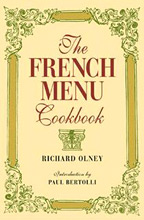Review © 2002 by Burton Kaplan
The French Menu Cookbook
Richard Olney
Ten Speed Press, Berkeley
456 pp, hdbk, $29.95
(also distributed in Australia, Canada, New Zealand, South Africa, Southeast Asia, and in the United Kingdom and Europe)
ISBN 1-58008-385-4

Ahead, on the crumpled waters of the Bosporus, running lights of ferries twinkled in the distance - marine fireflies welcoming night's abrupt descent on the Orient. Behind us, meanwhile, at Europe's trailing edge, the Seraglio's minarets and domes lingered in the ravishing backlit reds, golds, and blacks of an operatic sunset.
Between worlds in more ways than one, my companion and I had not eaten since breakfast. Now it was too late now for tea, too early for dinner. Pangs had driven us from touring the wholesale fish market to this nearby cookshop, Havyar. There was only one problem: we spoke no Turkish, they nothing but.
Enter Ahmet, he of the Guinness Book of Moustaches. Two snaps of his plump fingers and we were shown to table. A handclap brought forth a rolling bar bearing a dozen different vodkas. "Help yourselves" was the unmistakable message of his body language.
Another gesture here, a frown there and, abracadabra!, a balance-pan scale materialized, followed by trays of toast-points, crumbled egg yolks, and lemon wedges. A moment later, attended with pomp and ceremony, a frosty, unmarked tin about the size of a large biscuit cutter appeared. Ahmet weighed it, noted the grams on a chit beside the scale, broke the seal, and, left us.
The light meal that followed consisted only and entirely of the can's glistening contents along with its solid and liquid accompaniments. It was caviar, of course, (thus the Havyar of the restaurant's name) but of a glorious sort and quality we had never before tasted. Harvested, we later learned, from beluga native to the Black Sea, the firm pewter-grey berries were hastened fresh to Istanbul for immediate local consumption almost, but not entirely, free of salt. Crunched in the mouth, these toothsome pearls exploded with nutlike and mildly briny flavors that, together, conspired to leave tastebuds figuratively ready to light a cigaret and ask, Was it as good for you as it was for me?
Any guilt we might've harbored over our lavish Turkish bash was instantly dispelled with presentation of the bill. The total was arrived at by weighing the tin at the close of the meal, subtracting its present weight from the original, multiplying the result by an all-inclusive pittance per gram to cover food and drink and service. The bottom line for nearly a quarter-pound of caviar? Little more than $ US 10.
Lest you wonder why I tell this tale now, let me explain. There is an ineffable you-can't-go-home-again quality about a vignette of 30 years ago that seems entirely appropriate to the imminent republication of the late Richard Olney's 1970 cookbook. Like my own between-worlds experience, the book's reissue suggests both timelessness and anachronism and, so, raises questions about which might be more appropriate in the present context, a review or an obituary.
In its strong favor, the underlying premise of the book - the occasion is the recipe for the meal, not vice versa - remains as valid today as yesteryear. From this emerges some 20 seasonal meal plans of varying formality. These are built from locally-sourced ingredients appropriate to the time of year in which they are properly and naturally harvested.
Understanding the mental discipline by which Olney orchestrates proteins, fats, carbohydrates, and wines into the finished compositions he calls "menus" affords readers a useful bit of teaching few authors, modern or semi-classic, provide.
"Each course," he writes, "must provide a happy contrast to the one preceding it: at the same time, the movement through the various courses should be an ascending one from light, delicate, and more complex flavors through progressively richer, more full-bodied, and simpler flavors. The wines, too should be flattered by - and should flatter - each accompanying course while relating to each other, as well in a similar kind of progression."
Olney's menus find articulation in some 150 recipes. Some, in the main his dessert formulae - among these one for fresh strawberries in Beaujolais, and another for figs in raspberry cream - are simply perfect. Not nearly as much can be said for his soups, starters and main dishes. While productive of worthy plates, the majority are too layered, complex, and time-consuming to be practical for any but the most dedicated (and least health-conscious) of today's home cooks. Consider his crayfish mousse - a wondrous dish to be sure. Its directions occupy two solid pages of unrelieved single-spaced type embracing nearly 800 unillustrated words calling for three sub-preparations. His zesty poivrade sauce, which he identifies as "one of the summits of classical cooking," took nearly six hours to produce a scant two cups. To begin to prepare his jellied poached chicken, which requires a picked and singed but otherwise uncleaned bird to be boned and eviscerated with its skin left intact, took one semiprofessional butcher nearly an hour.
On the topic of wine, the palette from which Olney works is entirely French. Some of his pairings are colorful, most drab. He says of Alsatian Gewurztraminer, "I cannot imagine it being drunk with anything but dessert."
His is not the sort of lyrical food writing one might enjoy between meals. The tonality of it strikes one reader as that of a self-hating expatriate American seeking to out-French the French. Save for some few spot drawings (cooking equipment and wine-labels) the book wants badly for the relief illustration can provide. The typography, one of the subtle ways publishers can add value to text, is perfectly pedestrian.
With this as with many re-issued books, the reader is unconsciously led to interrogate the culinary reality that is, and compare it with what was. This is not to imply that this possibly useful title is either historically amusing or dead on arrival. Rather, it is to suggest that if one wishes to consider it an intellectually interesting reference resource it is well to do so knowing that it is largely if not entirely detached from life in the kitchen as we live it today.
All of which just goes to show you that, in the end, Oscar Wilde was right.
"To get back one's youth," he quipped, "one has merely to repeat its follies."
July 2002




